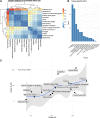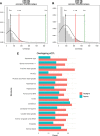Brain region-specific effects of nearly fixed sapiens-derived alleles
- PMID: 35546225
- PMCID: PMC9097168
- DOI: 10.1186/s12863-022-01048-8
Brain region-specific effects of nearly fixed sapiens-derived alleles
Abstract
The availability of high-coverage genomes of our extinct relatives, the Neanderthals and Denisovans, and the emergence of large, tissue-specific databases of modern human genetic variation, offer the possibility of probing the effects of modern-derived alleles in specific tissues, such as the brain, and its specific regions. While previous research has explored the effects of introgressed variants in gene expression, the effects of Homo sapiens-specific gene expression variability are still understudied. Here we identify derived, Homo sapiens-specific high-frequency (≥90%) alleles that are associated with differential gene expression across 15 brain structures derived from the GTEx database. We show that regulation by these derived variants targets regions under positive selection more often than expected by chance, and that high-frequency derived alleles lie in functional categories related to transcriptional regulation. Our results highlight the role of these variants in gene regulation in specific regions like the cerebellum and pituitary.
Keywords: Brain; Gene regulation; Human evolution; cis-eQTL.
© 2022. The Author(s).
Conflict of interest statement
The authors declare that they have no competing interests.
Figures



Similar articles
-
Evidence that the adaptive allele of the brain size gene microcephalin introgressed into Homo sapiens from an archaic Homo lineage.Proc Natl Acad Sci U S A. 2006 Nov 28;103(48):18178-83. doi: 10.1073/pnas.0606966103. Epub 2006 Nov 7. Proc Natl Acad Sci U S A. 2006. PMID: 17090677 Free PMC article.
-
Deleterious variants in genes regulating mammalian reproduction in Neanderthals, Denisovans and extant humans.Hum Reprod. 2021 Feb 18;36(3):734-755. doi: 10.1093/humrep/deaa347. Hum Reprod. 2021. PMID: 33417716
-
Functional implications of Neandertal introgression in modern humans.Genome Biol. 2017 Apr 3;18(1):61. doi: 10.1186/s13059-017-1181-7. Genome Biol. 2017. PMID: 28366169 Free PMC article.
-
Archaic human genomics.Am J Phys Anthropol. 2012;149 Suppl 55:24-39. doi: 10.1002/ajpa.22159. Epub 2012 Nov 2. Am J Phys Anthropol. 2012. PMID: 23124308 Review.
-
[Genetics and origin of Homo sapiens].Med Sci (Paris). 2019 Jan;35(1):39-45. doi: 10.1051/medsci/2018311. Epub 2019 Jan 23. Med Sci (Paris). 2019. PMID: 30672457 Review. French.
Cited by
-
What made us "hunter-gatherers of words".Front Neurosci. 2023 Feb 9;17:1080861. doi: 10.3389/fnins.2023.1080861. eCollection 2023. Front Neurosci. 2023. PMID: 36845441 Free PMC article.
References
Publication types
MeSH terms
LinkOut - more resources
Full Text Sources
